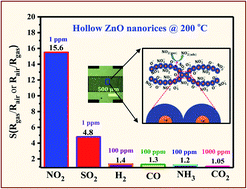Hollow ZnO nanorices prepared by a simple hydrothermal method for NO2 and SO2 gas sensors
Abstract
Chemoresistive gas sensors play an important role in detecting toxic gases for air pollution monitoring. However, the demand for suitable nanostructures that could process high sensing performance remains high. In this study, hollow ZnO nanorices were synthesized by a simple hydrothermal method to detect NO2 and SO2 toxic gases efficiently. Material characterization by some advanced techniques, such as scanning electron microscopy, transmission electron microscopy, X-ray diffraction, and Raman spectroscopy, demonstrated that the hollow ZnO nanorices had a length and diameter size of less than 500 and 160 nm, respectively. In addition, they had a thin shell thickness of less than 30 nm, formed by an assembly of tiny nanoparticles. The sensor based on the hollow ZnO nanorices could detect low concentration of NO2 and SO2 gasses at sub-ppm level. At an optimum operating temperature of 200 °C, the sensor had response values of approximately 15.3 and 4.8 for 1 ppm NO2 and 1 ppm SO2, respectively. The sensor also exhibited good stability and selectivity, suggesting that the sensor can be applied to NO2 and SO2 toxic gas detection in ambient air.



 Please wait while we load your content...
Please wait while we load your content...